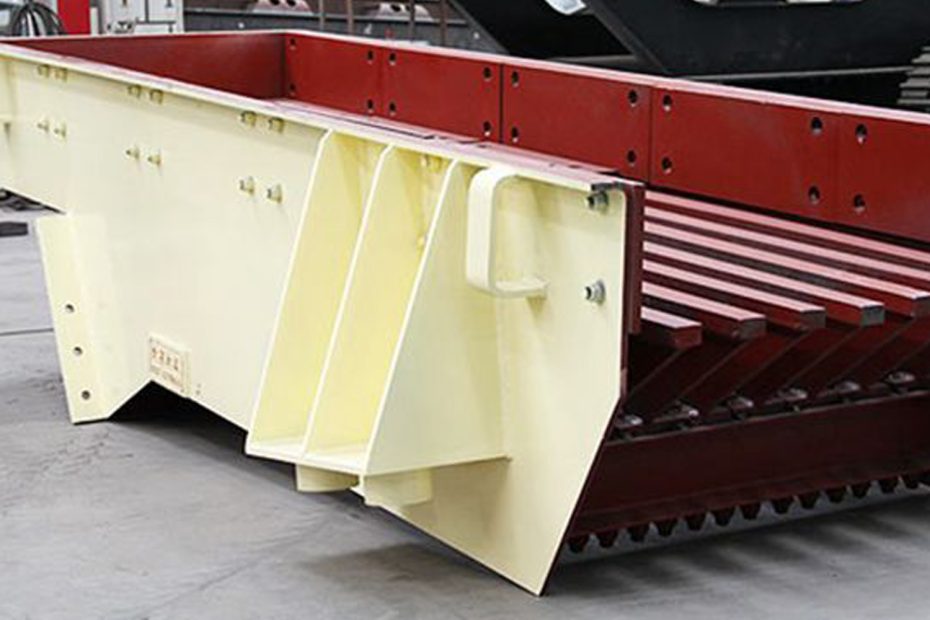Vibrating feeders are essential industrial equipment that plays a crucial role in conveying materials from one point to another with precision and efficiency. Before and after starting the operation of a vibrating feeder, there are several key aspects to consider to ensure its seamless performance.
A vibrating feeder also known as a vibratory feeder, is a machine that uses vibration to transport bulk materials, granules, or powders from one place to another. It consists of a tray, usually made of stainless steel or mild steel, and a mechanism that generates vibration.
The vibrating feeder has a simple structure, reliable operation, easy adjustment and installation, light weight, small size, and easy maintenance. When using a closed structure body, it can prevent dust pollution.The vibration causes the material to move in a controlled and consistent manner, making vibrating feeders invaluable in various industries, including mining, manufacturing, and agriculture.
Five factors to consider before operating a vibrating feeder
Before you commence operation with a vibrating feeder, it is essential to consider a range of factors to ensure smooth and efficient performance.
1. Material Properties
Understanding the properties of the material you intend to transport is paramount. Factors such as particle size, density, moisture content, and temperature can significantly impact the performance of the vibrating feeder. Make sure the feeder is designed to handle the specific characteristics of your material.
2. Feeder Design
The design of the vibrating feeder should match the material flow requirements. For instance, for materials prone to clogging, a feeder with a self-cleaning mechanism may be necessary. The size and shape of the feeder tray should also be suitable for the material.
3. Proper Installation
Correct installation is crucial for the feeder’s long-term performance. Ensure that the feeder is securely anchored and level to prevent unwanted vibrations or shifting during operation. It’s essential to follow the manufacturer’s guidelines for installation.
4. Power Supply and Control
The feeder’s power supply should meet the specific requirements of the machine. Additionally, ensure that the control settings are correctly configured for the material and flow rate you need.
5. Safety Measures
Safety should be a top priority. Implement safety measures such as guards and emergency stop switches to protect operators and prevent accidents during operation.
Four key points to consider when operating a vibrating feeder
Once the vibrating feeder is up and running, several key points must be continuously monitored to maintain its efficiency.
1. Vibration Settings
Regularly check and adjust the vibration settings to maintain a consistent and reliable material flow. Variations in material properties may require periodic adjustments.
2. Material Flow Control
Monitor the material flow to ensure that it matches the desired rate. Any disruptions or irregularities in material flow can be indicative of a problem that needs attention.
3. Lubrication and Maintenance
Regular lubrication and maintenance of the feeder’s components, including bearings and drive mechanisms, are essential for longevity and performance. Follow the manufacturer’s maintenance schedule.
4. Inspection of Wear Parts
Over time, certain components, such as the feeder tray or springs, may experience wear. Regular inspections can identify and address any issues before they lead to more significant problems.
Four major points of attention after the operation of the vibrating feeder is completed
After the initial operation, there are steps you should take to ensure the long-term health of your vibrating feeder.
1. Data Logging
Maintain a log of operation data, including vibration settings, material flow rates, and any irregularities. This data can be invaluable for troubleshooting and optimizing performance.
2. Regular Calibration
Periodically recalibrate the feeder to account for any changes in material properties or operational requirements. Calibration ensures the feeder continues to meet your needs.
3. Training and Education
Provide ongoing training for operators and maintenance staff. Knowledgeable personnel are better equipped to identify and address issues promptly, reducing downtime and maintenance costs.
4. Troubleshooting
Be prepared to troubleshoot any issues that may arise during operation. Common problems include material blockages, mechanical failures, and electrical issues.
Vibrating Feeder Operation Checklist
| Step | Description |
|---|---|
| 1. Material Analysis | Understand material properties. |
| 2. Feeder Selection | Choose the right feeder design. |
| 3. Proper Installation | Ensure secure and level installation. |
| 4. Power Supply | Match power supply to machine requirements. |
| 5. Safety Measures | Implement safety features. |
| 6. Vibration Settings | Adjust and monitor vibration settings. |
| 7. Material Flow | Continuously monitor and control material flow. |
| 8. Lubrication | Regularly lubricate and maintain components. |
| 9. Inspection | Inspect wear parts for signs of damage or wear. |
| 10. Data Logging | Keep records of operation data for reference. |
| 11. Calibration | Periodically recalibrate the feeder. |
| 12. Training | Provide training for operators and maintenance staff. |
| 13. Troubleshooting | Be prepared to address common operational issues. |
Conclusion
Vibrating feeders are indispensable tools in many industries, providing a reliable and efficient means of material transport. However, their successful operation depends on proper preparation before startup and vigilant maintenance during and after operation. By understanding the nuances of your specific application, adhering to safety guidelines, and following best practices, you can maximize the performance and longevity of your vibrating feeder.

